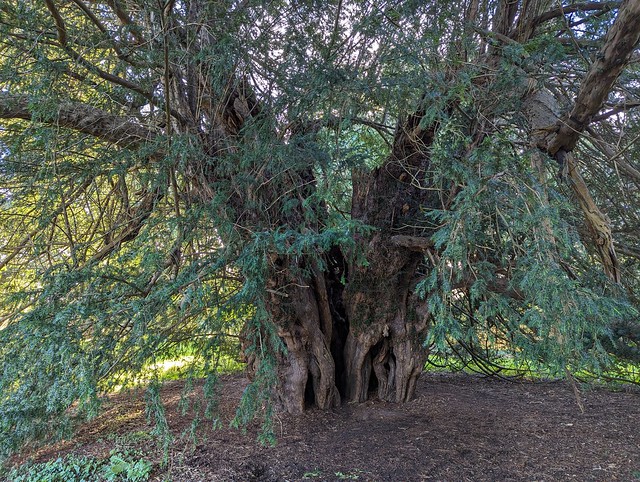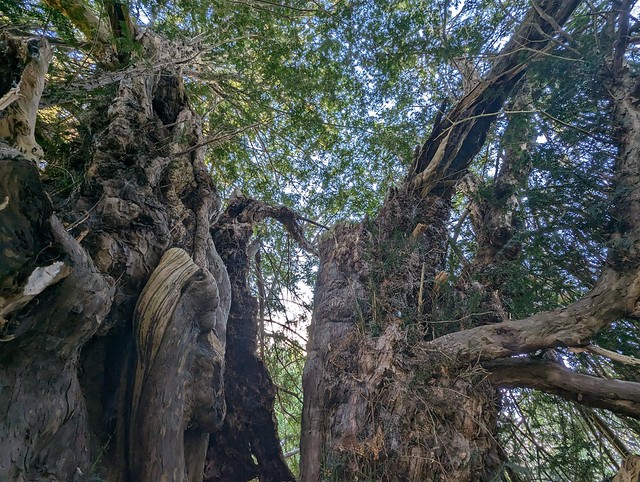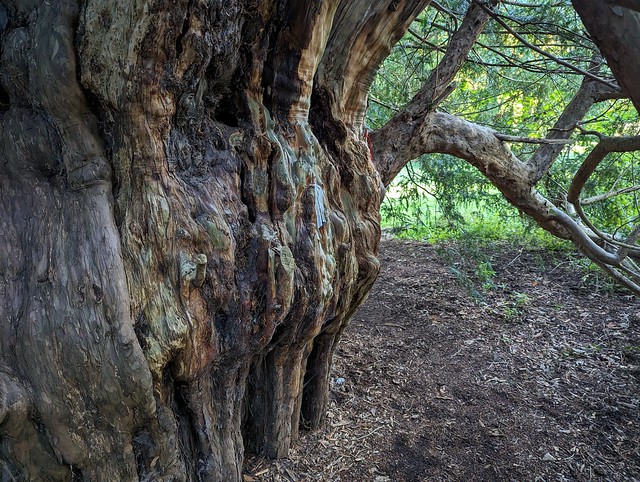15th October 2023
While I was walking along the nicely resurfaced towpath alongside the Thames at Runnymede someone stopped me to ask if I knew how to get across the river to Ankerwycke as they wanted to visit the ancient yew tree there. They’d been told there was a ferry but apart from one reference on a blog from 2018 to a proposed ferry I’m not aware that there’s been a ferry here in recent times. I directed her to the road route via Runnymede Bridge and the B376 to the small car park in Magna Carta Lane. Then I thought about how long ago it was that I last went there, which appears to be September 2015, so later in the afternoon I followed my own directions to Magna Carta Lane. From the small car parking area by Ankerwycke Farm a path leads along the edge of the field to an avenue of trees which you follow to your right to get to The Ankerwycke Yew & St. Mary's Priory.
The yew tree sits in a slightly raised grassy clearing with some simple wooden benches around three sides. It’s not particularly tall and is surrounded by much taller trees. But for a small sign you could walk past it and hardly notice what is at first sight another large bush. Walk clockwise around it though and it reveals a different face altogether.
The tree is at least 1400 years old and it is believed as much as 2500 years old. He (for this is a male yew) has like most of us increased in girth over the years and if he needed trousers would be looking for a 26’ (8m) waist size. His trunk is deeply fissured, almost hollowed out and branches reach down to the ground on almost all sides.
It is cool under here, in more than one sense and when there’s no one else about eerily quiet. You get a sense of being in the presence of something old. Old enough to have witnessed had he had eyes to do so, from his slightly raised area in what would then have been a marshy flood plain King John and the barons sealing Magna Carta on the far bank of the Thames. Also allegedly Henry VIII “courting” Anne Boleyn at a somewhat closer distance, although those two seem to have got it on all over the place if all such stories are to be believed. In here you can see that even the thicker parts of the trunk still sprout leaves and where the trunk is bare people have fastened small ribbons, a practice that might date back a long way.
Or maybe just to the 1980s, who knows? The tree obviously but he’s saying nothing.
The tree hasn’t noticeably changed since last I was here but coming out from under the canopy I found something that has. A few yards away stand the remains of St. Mary’s Priory, a Benedictine nunnery established around 1160 and dissolved in 1536 - maybe history would have taken a different course had the nuns chased Henry out from under that tree. In 2015 the ruins were securely fenced off and looked like this:
In 2022 they were excavated and seem to also have been given a thoroughly good scrubbing so that in this afternoon’s bright autumn sunshine they were so bright it almost hurt the eyes!
The fence has gone, along with the signage, though whether that removal is permanent I don’t know as the site still has a bit of a building site air about it.
From the abbey I walked through the woods to the bank of the Thames opposite Runnymede Pleasure Grounds and then back again via the yew. It was quiet, especially compared to the hubbub on the far side of the river where I’d been earlier.
It’s worth visiting this slightly out-of-the-way part of the National Trust’s Runnymede properties, even though it can be rather muddy getting to it, not too bad this time but evidenced by the row of boot-cleaning brushes fixed to the bottom of the sign in the Ankerwycke car park. If you want to get hands-on with the yew tree I suggest you visit sooner rather than later though. This has appeared at the end of the avenue of trees leading to the yew and abbey.
It reads "The National Trust is working with a team of consultants to improve your experience at Runnymede and Ankerwycke.
The Ankerwycke Yew is an ancient tree and we’re taking steps to protect it for the future. We’re building a new boardwalk a safe distance away from the Yew so visitors can view the tree without damaging its sensitive roots.
More to come
Scan the QR code to find out more about what we've been up to."
The Ankerwycke Yew is an ancient tree and we’re taking steps to protect it for the future. We’re building a new boardwalk a safe distance away from the Yew so visitors can view the tree without damaging its sensitive roots.
More to come
Scan the QR code to find out more about what we've been up to."
I can find no plans online detailing how they are going to “improve my experience” and the QR code doesn’t link to anything useful. I’m unconvinced regarding the protecting the roots thing and the official National Trust walk guide encourages you to "Make sure to stop and have a look underneath the canopy of this venerable old giant.”. If footsteps have been a problem for 2500 years the tree doesn’t seem to be doing too badly. It’s hard to see in the above photo because of the light behind the translucent hoarding but the artists impression looks as if the boardwalk will be some distance from the tree, possibly the other side of the stream that runs across the site. If so you won’t be able to visit the tree, only visit a place where you can see the tree “over there”. Your Ankerwycke Yew Experience will be a bit like your Stonehenge Experience. Though with fewer “Druids”.
Speaking of the National Trust, if you are a member and reading this blog at the time it was published can I please encourage you to vote in the AGM to prevent the Tufton Street crooks, GBNews poundland-fascists, and the frog-faced f*ckwit of “Retore Trust” from taking over.
And if you’re reading from the future I hope that you can still get up close and personal with the Ankerwycke Yew. No licking it though for obvious reasons and wash your hands afterwards :-)









No comments:
Post a Comment